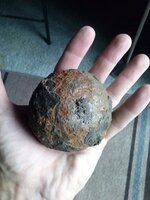TrpnBils
Hero Member
I found what I believe to be a Revolutionary War era 3# cannonball this morning at a colonial era river ford where we have found Spanish silver and a few colonial coins and large cents lately. I have a couple of questions for you (or whoever):
Diameter is measuring 2.86" after hammering off some of the rust which matches up with the 3# data I found, BUT the weight is up a couple of ounces at at 3lbs 4oz using a kitchen scale. How much of the increase there can be accounted for by the rust and/or the fact that it's been submerged in water for potentially up to ~250 years....can they retain water after submersion?
The photo below is immediately after I got home this morning and before the rust was knocked off which accounts for some irregularities in the surface in that photo. Looks to be perfectly spherical though now that it has been beat up a little.
Diameter is measuring 2.86" after hammering off some of the rust which matches up with the 3# data I found, BUT the weight is up a couple of ounces at at 3lbs 4oz using a kitchen scale. How much of the increase there can be accounted for by the rust and/or the fact that it's been submerged in water for potentially up to ~250 years....can they retain water after submersion?
The photo below is immediately after I got home this morning and before the rust was knocked off which accounts for some irregularities in the surface in that photo. Looks to be perfectly spherical though now that it has been beat up a little.





